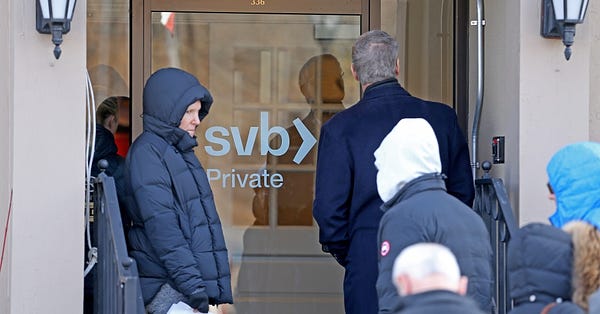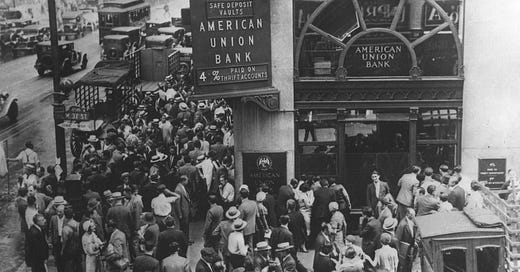Michael Hudson: Why the US banking system is breaking up
Economist Michael Hudson responds to the collapse of Silicon Valley Bank, and explains the similarities with the 2008 financial crash and the savings and loan crisis of the 1980s.
The California-based, cryptocurrency-focused Silvergate Bank collapsed on March 8. Two days later, Silicon Valley Bank went down as well, in the largest ever bank run. The latter was the second-biggest bank to fail in US history, and the most influential financial institution to crash since the 2008 crisis.
Economist Michael Hudson, co-host of the program Geopolitical Economy Hour, analyzes the disaster:
The breakup of banks that is now occurring in the United States is the inevitable result of the way in which the Obama administration bailed out the banks in 2009.
When real estate prices collapsed, the Federal Reserve flooded the financial system with 15 years of quantitative easing (QE) to re-inflate real estate prices – and with them, stock and bond prices.
What was inflated were asset prices, above all for the packaged mortgages that banks were holding, but also for stocks and bonds across the board. That is what bank credit does.
This made trillions of dollars for holders of financial assets – the One Percent and a bit more.
The economy polarized as stock prices recovered, the cost of home ownership soared (on low-interest mortgages), and the U.S. economy experienced the largest bond-market boom in history, as interest rates fell below 1%.
But in serving the financial sector, the Fed painted itself into a corner. What would happen when interest rates finally rose?
Rising interest rates cause bond prices to fall. And that is what has been happening under the Fed’s fight against “inflation,” by which it means rising wage levels.
Prices are plunging for bonds, and also for the capitalized value of packaged mortgages and other securities in which banks hold their assets against depositors.
The result today is similar to the situation that savings and loan associations (S&Ls) found themselves in the 1980s, leading to their demise.
S&Ls had made long-term mortgages at affordable interest rates. But in the wake of the Volcker inflation, the overall level of interest rates rose.
S&Ls could not pay their depositors higher rates, because their revenue from their mortgages was fixed at lower rates. So depositors withdrew their money.
To obtain the money to pay these depositors, S&Ls had to sell their mortgages. But the face value of these debts was lower, as a result of higher rates. The S&Ls (and many banks) owed money to depositors short-term, but were locked into long-term assets at falling prices.
Of course, S&L mortgages were much longer-term than was the case for commercial banks. And presumably, banks can turn over assets for the Fed’s line of credit.
But just as QE was followed to bolster the banks, its unwinding must have the reverse effect. And if it has made a bad derivatives trade, it’s in trouble.


Any bank has a problem of keeping its asset prices up with its deposit liabilities. When there is a crash in bond prices, the bank’s asset structure weakens. That is the corner into which the Fed has painted the economy.
Recognition of this problem led the Fed to avoid it for as long as it could. But when employment began to pick up and wages began to recover, the Fed could not resist fighting the usual class war against labor. And it has turned into a war against the banking system as well.
Silvergate was the first to go. It had sought to ride the cryptocurrency wave, by serving as a bank for various brand names.
After vast fraud by Sam Bankman-Fried (SBF) was exposed, there was a run on cryptocurrencies. Their managers paid by withdrawing the deposits they had at the banks – above all, Silvergate. It went under. And with Silvergate went many cryptocurrency deposits.
The popular impression was that crypto provided an alternative to commercial banks and “fiat currency.” But what could crypto funds invest in to back their coin purchases, if not bank deposits and government securities or private stocks and bonds?
What was crypto, ultimately, if not simply a mutual fund with secrecy of ownership to protect money launderers?
Silvergate was a “special case,” given its specialized deposit base. Silicon Valley Bank also was a specialized case, lending to IT startups. First Republic Bank was specialized, too, lending to wealthy depositors in San Francisco and the northern California area.
All had seen the market price of their financial securities decline as Chairman Jerome Powell raised the Fed’s interest rates. And now, their deposits were being withdrawn, forcing them to sell securities at a loss.
Reuters reported on March 10 that bank reserves at the Fed were plunging. That hardly is surprising, as banks are paying about 0.2% on deposits, while depositors can withdraw their money to buy two-year U.S. Treasury notes yielding 3.8% or almost 4%. No wonder well-to-do investors are running from the banks.
This is the quandary in which banks – and behind them, the Fed – find themselves.
The obvious question is why the Fed doesn’t simply bail them out. The problem is that the falling prices for long-term bank assets in the face of short-term deposit liabilities now looks like the new normal.
The Fed can lend to banks for their current short-fall, but how can solvency be resolved without sharply reducing interest rates to restore the 15-year, abnormal Zero Interest-Rate Policy (ZIRP)?
Interest yields spiked on March 10. As more workers were being hired than was expected, Mr. Powell announced that the Fed might have to raise interest rates even higher than he had warned. Volatility increased.
And with it came a source of turmoil that has reached vast magnitudes beyond what caused the 2008 crash of AIG and other speculators: derivatives.
JP Morgan Chase and other New York banks have tens of trillions of dollars worth of derivatives - that is, casino bets on which way interest rates, bond prices, stock prices, and other measures will change. For every winning guess, there is a loser.
When trillions of dollars are bet on, some bank trader is bound to wind up with a loss that can easily wipe out the bank’s entire net equity.
There is now a flight to “cash,” to a safe haven – something even better than cash: U.S. Treasury securities. Despite the talk of Republicans refusing to raise the debt ceiling, the Treasury can always print the money to pay its bondholders.
It looks like the Treasury will become the new depository of choice for those who have the financial resources. Bank deposits will fall. And with them, bank holdings of reserves at the Fed.
So far, the stock market has resisted following the plunge in bond prices. My guess is that we will now see the Great Unwinding of the great Fictitious Capital boom of 2008-2015.
So the chickens are coming hope to roost – with the “chickens” being, perhaps, the elephantine overhang of derivatives.





Michael Hudson is one of the world's most brilliant economists. Why doesn't he and a few others have more influence on gov't policy? The US has a huge brain trust of world class academics but they are only heard on the margins while the useful idiots stumble from one disaster to another.
Only one thing is clear: No actual banksters will go to jail but they will crucify the stupid kid with wild hair and shorts who, like Bernie Madoff, really had nothing to do with this but can be made to stand as a media distraction. They might even use him to destroy crypto while they're at it.